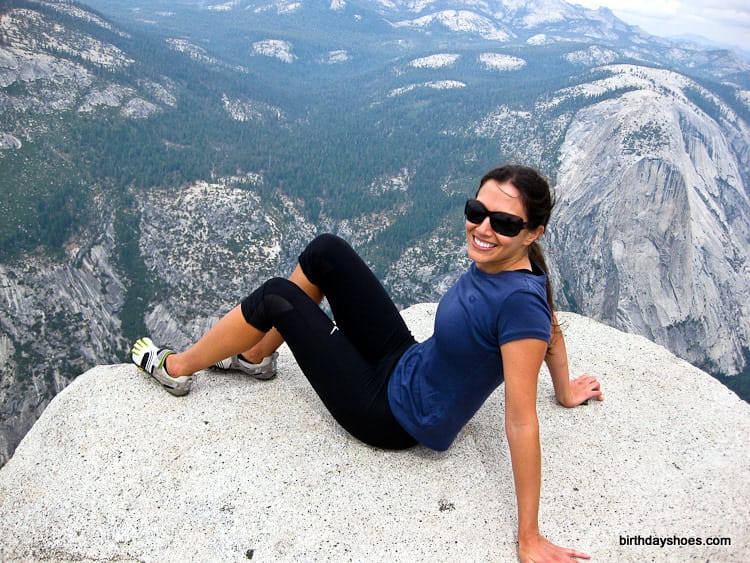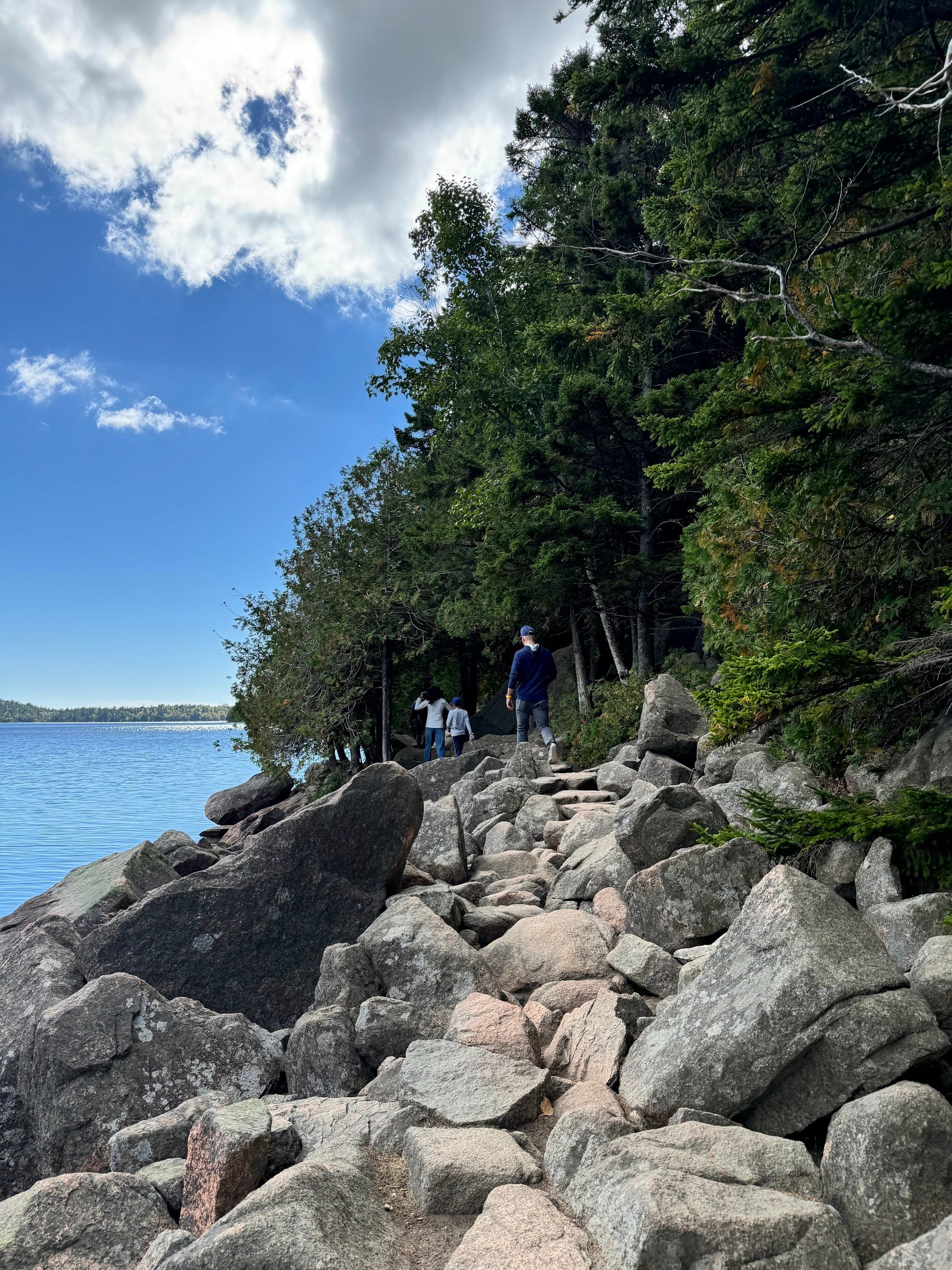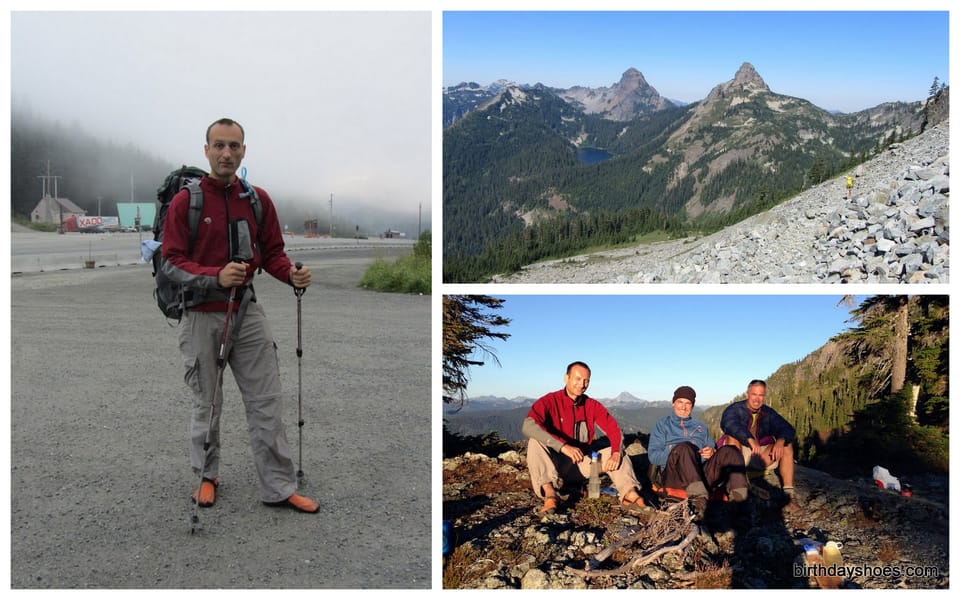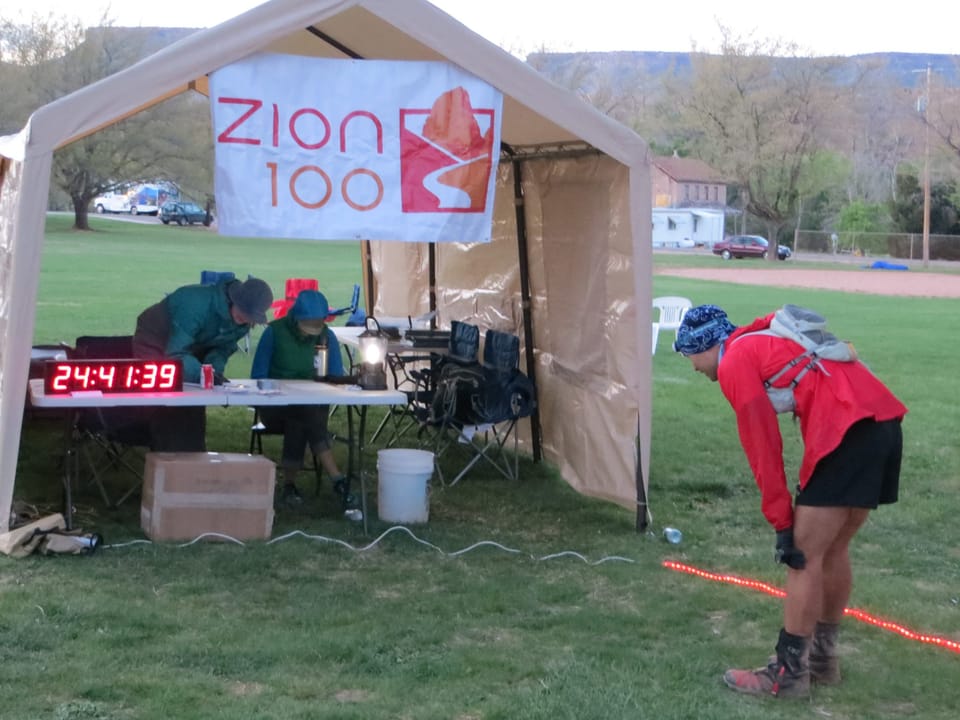Interview with Rob Youngren
Why did you switch to minimalist shoes? Strictly speaking I haven't switched over completely to what most people these days consider “minimalist” shoes. Six or seven years ago a minimalist shoe was any shoe that weighed less than 10oz and was lower pr…
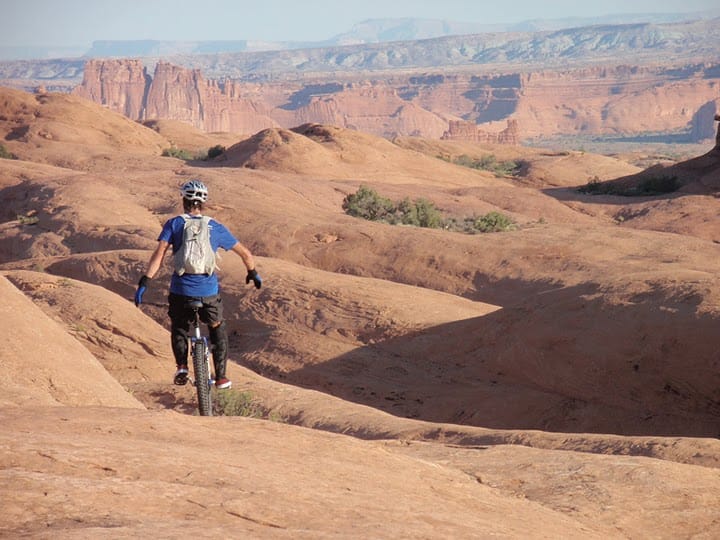
Rob Youngren is an ultra-runner, unicycler, and blogger here on BirthdayShoes.com. He's based out of Alabama and has been running for twenty years. As a matter of course, he started running in lighter weight, more minimalist shoes, ultimately retraining his foot strike (to midfoot) long before the revival of "minimalist running."
Rob brings an incredibly unique perspective to the BirthdayShoes blogger-crew — one some will find at odds with some minimalist dogma (e.g. Rob is a believer in arch support and cushioned shoes for high mileage runners). His contrary views are born of loggin some 50,000 miles of running, so when I hear his opinion, I usually listen up.
So below is an interview with Rob that talks about his story, where all this is going, his own footwear experiences, and more. It's a fascinating read, so sit back and read on!
Hey Rob! So tell us: why did you switch to minimalist shoes?
The summarized version: I was experiencing lower leg issues and decided I needed to try a different approach so gradually transitioned to running in much more low profile, light weight trail shoes. I also changed the way I ran because I was a wicked heel striker, now I’m a fairly efficient midfoot striker. I do still wear arch supports however.
Wait, what? Arch supports? What's the story?
The long version: Strictly speaking I haven't switched over completely to what most people these days consider “minimalist” shoes. Six or seven years ago a minimalist shoe was any shoe that weighed less than 10oz and was lower profile and lower heel-to-toe drop than most shoe offerings at the time. In other words a “minimalist” shoe was essentially a racing flat. I kind of chuckle these days when I see all the new “minimalist” offerings cropping up as to me they are basically redesigned racing flats.
Anyhow, I’ve been running since 1991 and running ultra marathons since 1995. Early on I used to train and compete mostly in racing flats; one of the early Adidas Adios models. Over time as my focus shifted to running and racing on trails I found I needed more protection so I gravitated towards wearing the trail shoes of the day. Back then there were not so many choices but the best at the time were shoes made by Montrail (in my opinion) so I ran in the Montrail Vitesse for many years (anybody remember that shoe?). It was a behemoth of a shoe, really an extremely lightweight hiking shoe but a real clunker, however it was also insanely comfortable and protective and saw me through many an ultra adventure.
However, after many years of abuse I started having plantar fasciitis, knee tracking issues and Achilles tendonitis. I was a horrible heel striker. I would quickly wear wedges out of the heels of my shoes! I knew something needed to change. So I decided to try something different with my choice of shoes. This was before toe shoes—and Born To Run had yet to be written. Nobody was running in huaraches (at least around here). But there was this relatively new trail shoe company (to the U.S.) called Inov-8 which was making very low profile, lightweight shoes that had reduced heel-to-toe drop. I thought why not give them a shot?
At first everybody thought I was crazy to be running on too “little” a trail shoe, they said I needed more protection, that my feet would be hamburger if I tried to run ultras in them. Well they were wrong! While they took a while to get used to I did successfully make that transition, which was a big deal back then. During this process I also taught myself to midfoot strike. At first I really had to focus, step by step to not heel strike. After a while the midfoot striking became more natural for me until I no longer had to consciously think about it. This process took many months, possibly almost a full year in fact. So my advice is to take the transition slowly and only if you’re having issues; don’t just change the way you run or the shoe you wear just for sake of change. I was euphoric; I'd been used to wearing big clunky trail shoes that weighted over a pound each! Now I was wearing shoes that weighed just a fraction of that and had significantly less heel-to-toe drop. I even eventually weaned myself from wearing arch supports. I really thought I'd come a long way. And I continued to run in Inov-8s for all my running, trails and roads for several years.
But then almost a year ago I sustained a stress fracture to my calcaneous (heel bone). I was unicycling the famed Slick Rock Trail in Moab, Utah (very, very tough trail but one of the most fun as well) when I came off the unicycle (something that happens routinely quite a bit, no big deal—I'll circle back to mountain unicycling in a bit). I guess this instance was one time too many and I landed on my heel quite hard and BAM stress fracture. I think this injury would have happened eventually, sooner or later because of the big heel spur I had. Turns out I had a major heel spur on my calcaneaous and when I landed hard on my heel during a fall the spur literally broke off; separated from my heel bone right at the plantar fascia insertion point! Ouch! It was this heel spur that was causing my plantar fasciitis issues all along (I still had mild cases even after I transitioned) and while being stuck in a cam-walker boot for 3 months was the pits (longest I've been out of running in over 20 years!) coming back after has been great; no heel spur = no more plantar fasciitis issues!
However, after talking with my orthopedist I now fully understand more about the muscular and tendon dynamics between the calf, Achilles and plantar fascia and the forces involved with running and how that affects the plantar fascia. I was educated on just what causes heel spurs; the repetitive stressing of the plantar fascia at the insertion point because of lack of arch support creates micro fractures on the calcaneous at the insertion point of the plantar fascia that over time continually heal (at night) and fracture, heal and fracture. After years of this cycle the bone at the insertion point begins to distort and pull away creating a spur. It’s this spur, knife like that aggravates the rest of the muscles and ligaments in the area. Thus, plantar fasciitis issues! I also learned that I was even more prone to heel spurs since I run A LOT, like 50-80 miles a week, week after week, year after year.
In short, my only hope to continue my passion for running was to go back to using arch supports. The plantar fascia is not meant to flex or stretch in excess; it isn’t a muscle! The orthopedist showed me on a model the connective tissue and muscle relationships between the plantar fascia, Achilles muscle and calf muscles. I’m a believer in arch supports now for people who run as much as I do and who frequently race very long distance races. In short, the more you run, the more protection you most likely need. My body has been pounded for long enough that running with arch supports is just the price of doing business for me. So nowadays I rarely run without arch support unless it's a relatively short run for me (less than an hour or less than 10 miles or so). So, while most of my shoes these days have modest stack heights with ample cushioning and protection (necessary for trails I run), they mostly don’t have more than 4mm of heel-to-toe drop and have ample toe boxes for proper toe splay.
Finishing my 335 mile speed-hike of the Pinhoti Trail (in record time)
Would you mind elaborating a bit on how arch supports reduce stress on your plantar fascia?
Let me preface by saying that I'm not an othopedist or doctor and what I learned, I learned by reading and from explanations from my orthopedist.
Ok, so I'd been in a cam walker boot for over 3 months (after sustaining that calcaneous stress fracture) and my orthopedist said and he didn't want me to attempt running again for another month! So I sought out a second opinion as I was experiencing zero foot pain and was chomping at the bit to get going again. This orthopedist took an x-ray of my foot and proceeded to tell me that he saw no reason I couldn't start running again—albeit little by little and slowly ramp up. Great. So my next question to him was how do I prevent getting these heel spurs? What can I do?
At this point he brought out a model of the foot that had the Achilles muscles, various tendons, and fascia. He showed me how they all interrelate and explained that the plantar fascia is not a muscle and can't/shouldn't be stretched. He explained how the plantar fascia functions and that excessively taxing the plantar fascia, over time, over a lot of pounding and a lot of miles run really works the plantar fascia, especially at the insertion point in the calcaneous (right where my stress fracture occurred). As that insertion point gets overused it causes pain as micro-fractures appear as the the plantar fascia is literally trying to tear away from the calcaneous. As one continues to run they get into this viscous cycle of micro-fracturing and healing, micro-fracturing and healing until, overtime a spur develops.
This effect is also seen with Achilles spurs and other sorts of spurs in the foot. With a heel spur you now have a piece of rigid bone that can continually aggravate the tissue and tendons in the foot, particularly the plantar fascia. So my orthopedist then explained that to reduce this effect one has to minimize the amount that plantar fascia can flex. In my case my plantar fascia was flexing too much thus causing my heel spur issues. So arch supports have been found to reduce the amount of plantar fascia flexing and so potentially reduce the possibility of having issues like I just described. I'd heard and read about this before but now it was very real to me, I'd been through bouts of plantar fascia issues for many years. I also recalled how when I originally was having PF issues that I was advised to try arch supports. Back then as now I've found that they really seem to be helping me as I haven't had any recurrence of PF issues since—despite a steady diet of punishing mileage, runs and races.
The need for arch supports for sustained, week-in-and-week-out long-distance running might be seen as running contrary to theories that human beings evolved to run long distances ... What do you make of the theory put forth mainly by Daniel Lieberman that we evolved to run (generally) and that we're adapted (specifically) to long-distance running?
I respect Liebermann and the other various studies that are trying to demonstrate the "Born To Run" theory. Perhaps in time there will be more widespread and long term studies conducted that would help support Liebermann's theory. Right now though I think it's far too early to tell. What studies have been done have been far too limited, contained too small a sampling pool, or too specialized to be statistically significant. On the other hand let's assume Libermann's theory is valid, that human beings have evolved to run long distances. How far? How often? What do me mean by long distance? At what pace? Over what kinds of terrain? If we consider long distance to be the point of total glycogen burn (18-20 miles for a lot of folks) then what about those of us who regularly run further than that; beyond the supposed human norm? I just think there are still a lot of questions that remain to be answered.
I do believe as human beings we are not meant to be sedentary, we are indeed designed to get out and move, walk, run, etc... yet I do believe that not all of us are predisposed to have perfect form or body mechanics, thus the need to use tools to assist us i.e. arch supports, some level of cushioning in our shoes to mitigate damage caused by running over rough terrain etc...
Like I also said earlier, it all depends on how much you do. If one were to run for wellness only and perhaps the occasional 5km race, so say 30 minutes a day so that's perhaps at most 20-30 miles a week. Ok with that relatively low amount of mileage (or less) I can totally see running just about however you want: barefoot, VFFs etc... Now say you do all that mileage on rough, rocky trails? Now things get a bit harder, now perhaps you'll start to realize the need to have a bit more underfoot protection. Now expand that out, double the mileage and on the same rough terrain now one should be able to see that perhaps they might require a more substantial shoe some of the time. Now do that for 1000s of miles a year, year after year of pounding, your body is strong but worn, perhaps they might understand that arch supports and other tools might be more necessary.
What is the most important aspect of minimalist footwear for you?
Low heel-to-toe drop and toe splay. The low heel-to-toe drop I think is very important from a body posture and running mechanics stand point; it's much tougher to run with a midfoot like I do with a high amount of drop. Toe splay is very important, especially in longer distance runs. I don't often blister but if I do it's usually between my toes simply because the shoe I wore didn't have enough toe room and so the toes rubbed together to blister. Also allowing toe splay should reduce the tendency to develop bunions and other possible podiatric issues. I think most of my running mechanical issues of the past were solved by the introduction of a lower heel-to-toe drop shoe which made it easier to learn to midfoot strike. In retrospect I should never have abandoned my arch supports.
How many pairs of FiveFingers do you have? What other minimalist shoes do you have?
Just a couple and I’m not crazy about them; Classics and KSO. The originals! I never really got too into the toe shoe craze. I did go through a phase where I'd run in them every other day and up to 25-33% of my weekly mileage including track speed work and a few 10 mile runs. Sorry, but I really tried to like them but couldn't get over how goofy I looked in them (my opinion). I was also trying to really ramp up my mileage in training for the Badwater Ultramarathon last year and started to have a lot more foot issues trying to work in VFF running into my regular training diet (Achilles tendonitis and PF mainly). So I stopped running in them completely about a year ago. I still will take them out for a mile or so when I walk my dogs but that's all I want to do in them.
By the modern minimalist shoe definition I also own some VivoBarefoot shoes and a bunch of other reduced stack height, lightweight shoes that I call "racing flats." However most of my shoes probably wouldn't be considered "minimalist" by members of readers of this site; Inov-8, Altras, Hoka One One, and some other interesting new products from Skechers.
What's your current go-to shoe? All-time favorite?
My go-to shoe right now for the roads is probably a four way tie between the Altra Provision (review pending) or Altra Instinct (reviewed), Hoka One One Bondi B or the yet to be released Skechers GO Run Ride. On the trails I'm a huge Inov-8 X-Talon 212 fan, this is the only trail dedicated shoe I need! I’ve gone through many trail shoes in my day and so far nothing stacks up to most of the Inov-8 line.
My all time favorite is too tough to say as I've been running since 1991 and have seen a lot of my favorites come and go! But I've liked the Inov-8 X-Talon 212 for long enough now that I guess it fits the "all-time" category as I think it's hands down the best trail shoe I've ever worn. On the roads I don't know, my Hoka One One Bondi Bs got me through 135 miles of pavement last summer at the Badwater Ultramarathon without feeling very sore or beaten up so there is something to be said for this shoe! But I’m a realist as I know shoe designs and models will change and so it will always be a challenge to find the “it” shoe.
What is one activity enjoy doing that has nothing to do with FiveFingers?
When I'm not running, I enjoy unicycling both on and off road. I have been riding for almost 7 years. Just about anywhere I can mountain bike I can also ride my beefed up, fat tire unicycle! While unicycling I’ve: ridden down the tallest 14er in Colorado (Mt. Elbert), competed in two 12 hour off road races against mountain bikers (and finished far from last in each), ridden the famed Monarch Crest Trail in Colorado, ridden in multiple sprint triathlons, ridden a 100 miles in a little over 8 hours, and had many other adventures!
Unicycling is great fun but did take a while to learn to not only simply ride but learn to ride trails! It’s great cardio cross-training for runners. If you can get over the circus stigma and the huge learning curve (you’ve got to be very stubborn!) it's a great workout and great fun! These days, since my injury, I'm not riding off road quite so much but do enjoy riding around every now and then when the weather is nice and trails are dry.
What is the most important aspect of minimalist footwear for you?
Like I’ve said, reduced heel-to-toe drop 0-4mm and an ample toe box for proper toe splay. I also like fairly minimal stack height as long as the shoe has enough cushioning and underfoot protection for off road use.
Show us a picture of your the shoe you wore before you transitioned to minimalist shoes?
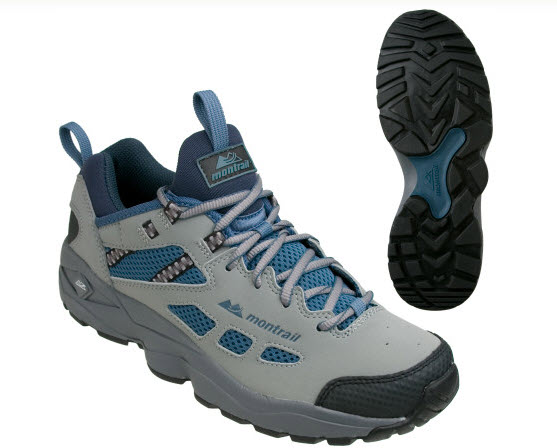
Figure 1. The aforementioned clunky but light Montrail Vitesse, circa 1997-2007 (estimated), 13oz / 358.5 g EACH
If you could only wear one style of shoe for the rest of your life what would it be? Not just the brand but the model as well.
Probably just about anything in the Altra line of shoes. Their products, especially the Instinct and Intuition hit most of the qualities that I think makes a great lifestyle and running shoe.
How long did it take you to transition to minimalist shoes?
To transition from my old clunky trail shoes to the types of shoes I wear regularly now took well over a year. I knew I’d made the transition when I could no longer stand wearing my old go-to 100 mile race shoe the Montrail Vitesse. That was both a happy and sad day as I was happy to have transitioned but at the same time I was saying farewell to an old friend!
Do you prefer Socks or No Socks?
Always socks. I'd rather get my socks funky over my shoes, plus I do a lot of trail running and having a sock just adds another layer of protection.
How many people have you converted to minimalist shoes?
I can't say I have converted anybody over to "minimalist" shoes but I have convinced a lot of folks to try running in more reduced trail shoes such as the Inov-8 line. They are a very superior trail shoe in my opinion. I think I have also helped educate folks about the dangers of over striding and excessive heel striking. And the advantages of running in reduced heel-to-toe drop shoes.
If you could design your ideal shoe what would it be?
The basic template would be Altra’s anatomically shaped footbed but with the upper of the Inov-8 X-Talon but with more substantial toe bumper. The midsole/outsole would be some as yet uninvented foam and sticky rubber compound that had superior, firm cushioning properties while at the same time having awesome, all condition traction on trails. The trail version would have a mixture of lugs and posts for the tread, separated enough to not clog up with mud too bad but still have great off camber traction and enough surface area for grip on wet rock. I’d also throw in a very flexible, tough, very protective and light rock plate integrated into the midsole.
What perspective do you bring to your reviews at BirthdayShoes?
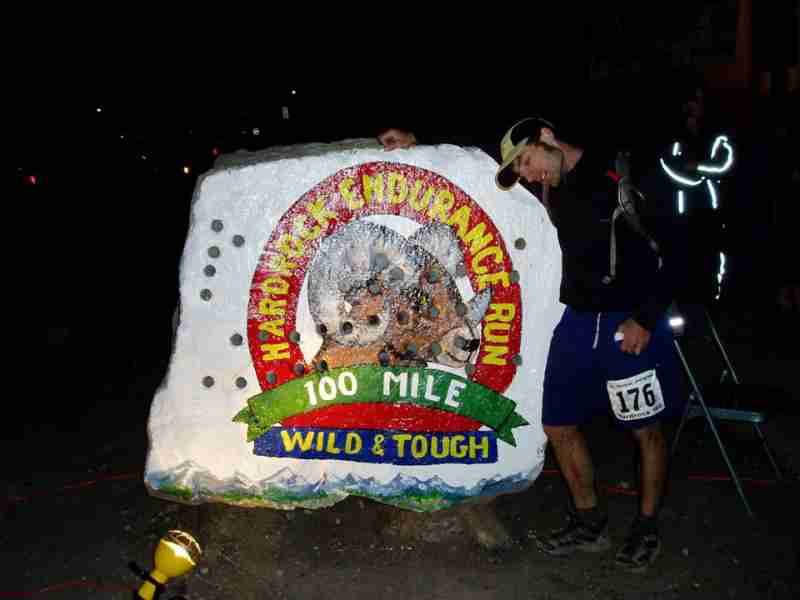
Finishing the 2005 Hardrock 100 Mile
I'm probably more of the Wily Old Veteran of the group. I'm 37 but I've been running since 1991 and have accumulated almost 50,000 miles running! So I've run in A LOT of different kinds of road and trail shoes throughout my career. I've also been a competitive ultra marathon runner since 1995 and have run almost 150 ultras, most of them over 50 miles. Therefore, I have a keen understanding about the types of footwear that work for long distance events on roads and trails and what type of footwear works for training for those events. So in a nutshell I have a perspective on running footwear that goes beyond the wellness or recreational running level that might be of some use to folks who are considering running distances or events beyond that level.
You clearly bring a dose of perspective and skepticism to the recent wave of interest in minimalist running shoes. What's your overall take on this movement?
Overall I think getting people and shoe companies to think about and discuss just "how much shoe" do you really need is important—to rethink why shoes have elevated heels in the first place (I have a theory about that), or why shoes typically have such narrow toe boxes or aren't very flexible.
While going ultra-minimal or barefoot for all my running is out of the question and not desirable I'm not against anybody who chooses to do so nor would I try to dissuade them. It's their prerogative. I just feel that "minimalism" in and of itself is not the final answer for all runners in all cases: it's one possible answer that may work for a lot of people but may not for a lot of others.
Any concerns about where it's going?
My only concern would be that folks take it way too seriously and become fanatical and overzealous. I also worry about the whole education side. I don't think there is near enough education out there available to the general public which is why there are a lot of people getting hurt trying out minimalist shoes. One has only to peruse BirthdayShoes.com's forums to see that there a a lot of people getting hurt. It all goes back to form. If your form is bad then running in a "nothing" shoe is going to get you into trouble. At least with a more substantial shoe your poor form might not get you into trouble as quickly. And vice versa if you have good form there is probably not a shoe you couldn't adjust to. So education is the key.
Interesting point re: more shoe might not get you into trouble as quickly if you've got poor running form. But how do you learn to run in the first place? Though it's not as incisive as Lee Saxby coaching your running form, I usually think true barefoot running maximizes sensory input (amplifying your mistakes). This can quicken the "rewiring" of your brain to learn a lighter form. Anyway, what's your take on learning to run?
I had good coaching back in high school and college. As part of our daily routine we'd typically do several "barefoot striders" on the football field at the end of practice. I think this was to help us learn better form, to get our brain and body used to what this felt like so that when we put shoes on we'd run the same way or attempt to. So I initially had good form but then the further I got from school I sort of got lazy, started using the large heel-to-toe drop shoes (which was the norm) and abandoned my, at the time, minimalist approach. I used to race everything in racing flats, the "minimalist" shoes at the time. So when I had to "teach" myself again more recently I went back to that "barefoot strider" approach and tried to reprogram my body and mind. Eventually it did work but I had to undue years of shitty form!
So yes, I'd totally agree that using some barefoot running is probably the best way to learn good form as long as it's done in a supervised fashion in a more controlled environment. I was lucky enough to have good coaches, not everybody does. In that case it would be awesome if there were more clinics out there that would basically just teach like this. Don't put a name on it just keep it simple. I suppose Pose and Chi are modern examples of this approach but I suspect there is much more to what they do than what I was trying to do. I think the end result may be the same. At the same time I still think you can learn good form in just about any shoe but yes, it is a bit more difficult since you can't feel what's right and what's wrong.
Any advice for folks wanting to get into running long distances who are minimalist running enthusiasts?
My main advice is don't try to be a purist or a zealot. Realize that there are situations and conditions where using a more substantial shoe (note: I'm not saying you need a traditional running shoe) is very beneficial, like running on very rough terrain or running much longer distances than you may be currently use to.
There is also the performance aspect to consider. Do you want to compete or do you want to complete? If you don't mind just participating in long distance races then you can probably get away (for a while at least) with whatever shoe you're currently wearing.
Now if you really want to maximize your potential you must realize that your handicapping yourself by not using tools that can help you realize that potential. Think about a long trail race, if you don't have to think about foot placement every step, think how much faster you could be? Or with ample underfoot protection (rock plate, modest midsole stack height) you won't have to worry so much about what you're stepping on. All that can add up to a lot of gained time. Much the same applies to longer distances on the roads. At some point your form can break due to fatigue, if you're in a very minimalist shoe you have to necessarily slow down to avoid injury since minimalist shoes can be almost worthless if your form has eroded. So with a bit more substantial shoe, yes even if your form goes at least you have some underfoot protection to see you through the race.
That's basically it. Realize shoes are just tools. Pick the right tool for the job!
Why do you enjoy running so much?
It all started from a very early age. Backpacking, hiking—just running around and playing in the woods with friends. Well as I got older I never grew out of enjoying the desire to explore the outdoors. So I joined my high school cross-country team and have been running ever since. I enjoy exploring new places. I enjoy exploring what I think my own limits are, time and time again. I work as a computer programmer and my day is stuck staring at a computer screen and analyzing lines of code; it's a great relief to get outside and run in the woods away from all the technology even if just for a little while. Really clears the head and replenishes my spirit.
I can't imagine not being able to get outside and explore.
Thank you, Rob, for the perspective and experience you bring that helps BirthdayShoes a success!
If you want to catch up with what Rob has been writing for the site, see a full list of his articles and reviews here.

